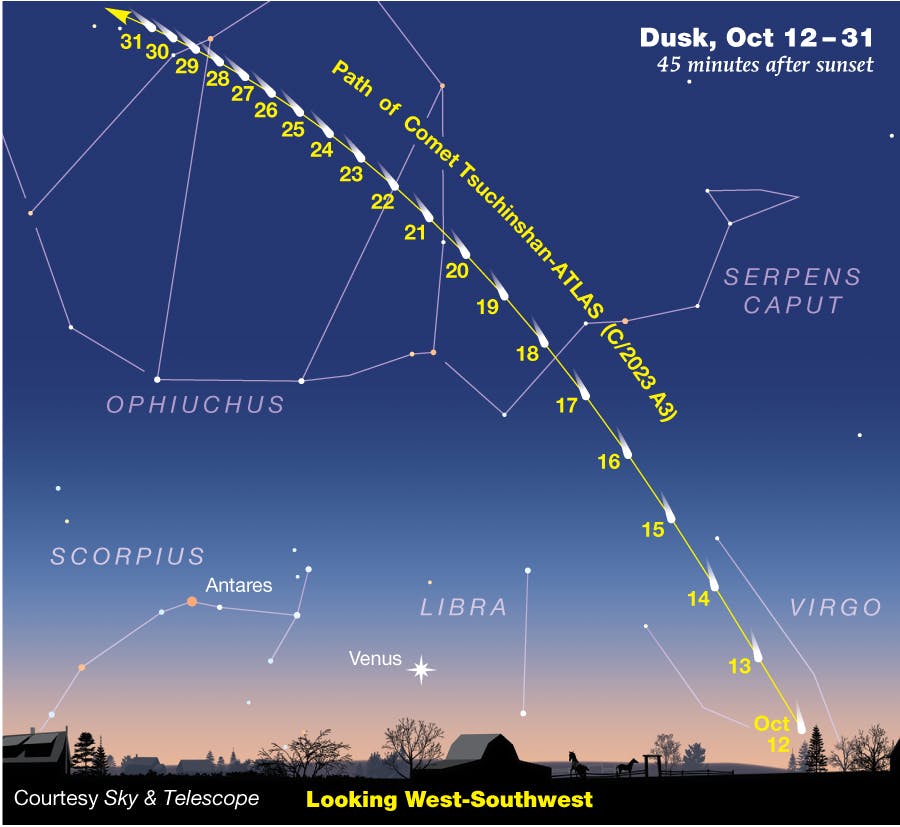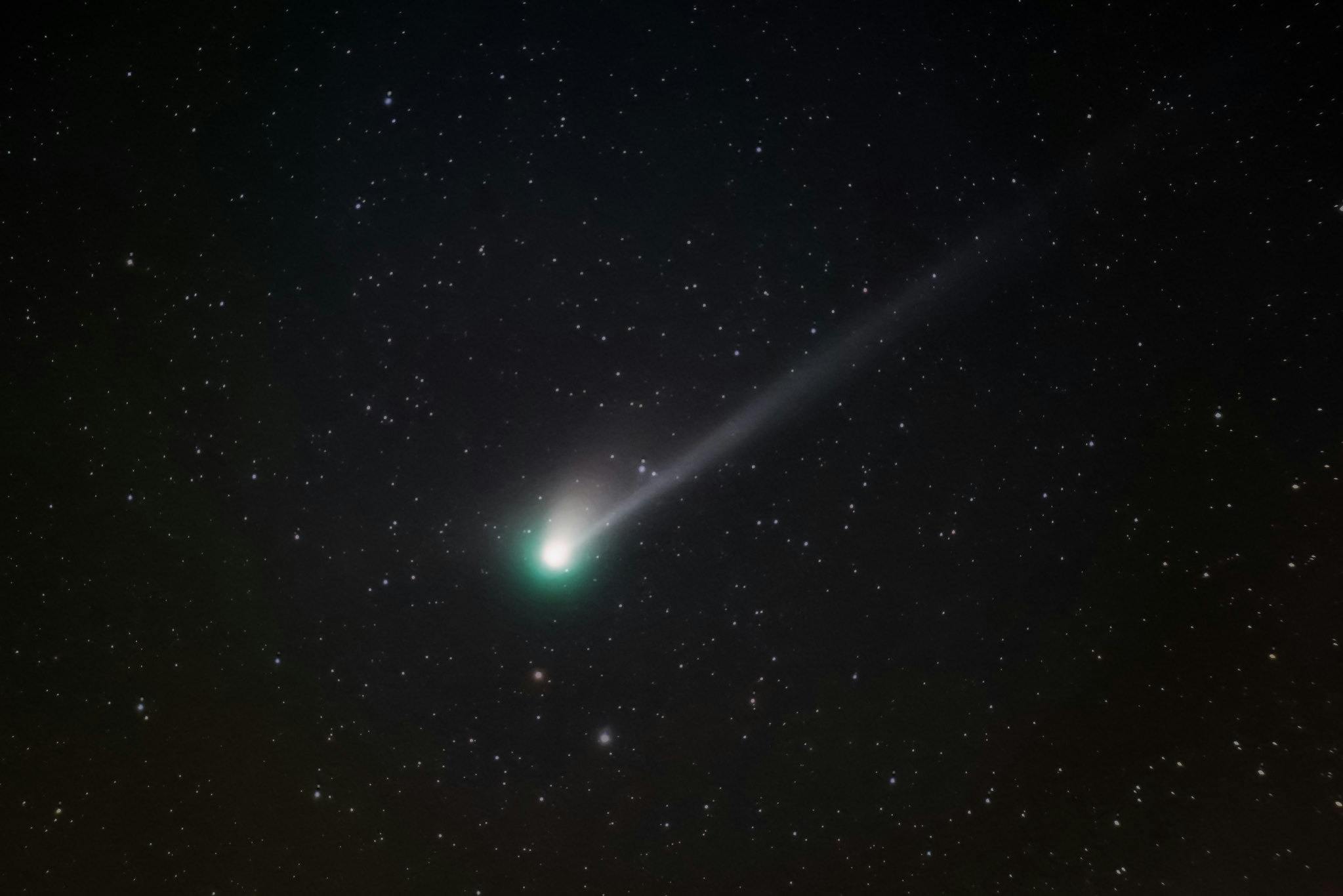See Comet Tsuchinshan-ATLAS over Iceland
From Saturday evening October 12, comet Tsuchinshan-ATLAS will be visible low in the twilight evening sky above Iceland, shortly after sunset. At first, the comet will be very close to the western horizon so in order to see it, you have to make sure neither mountains, tall buildings or trees block the view. It will be much easier to see when it climbs higher in the sky from October 14.
**Update October 14: The comet is now faintly visible to the unaided eye. Photographers have already caught beautiful images of it, for examples this magnificent photo of the comet above Snæfellsjökull glacier in west Iceland.
Gísli Már Árnason of Iceland at Night took these lovely images of Tsuchinshan-ATLAS from Kópavogur on October 13.
Now it's finally our turn to catch this beautiful comet from Iceland. It will probably be the most visually stunning comet seen from Iceland since McNaught in January 2007. Make sure you follow the cloud cover forecast on our website Iceland at Night.
We'll of course try to chase the comet and will publish images off of it here and on our Instagram.
Where to look?

The best time to catch the comet for the first time from Iceland is between October 12-15, when it has climbed a bit higher above the horizon after sunset. Try to look for it then, around 19:00 UT, very low in the west (towards sunset, use the compass on your phone if you find it hard to find west).
Timings below are approximations and takes into account clear view towards west and end of civil twilight in Reykjavík, when the Sun is 6 degrees below horizon and the sky should be dim enough. Use the times as reference on when to be outside to see it. Also keep in mind that the map here from Sky & Telescope does not represent the view from our location, so Venus is not visible in our sky.
October 11, 2024 - Tsuchinshan moves away from the Sun and climbs higher in the sky. This is perhaps the first evening you might see the comet, but it may be difficult. Go to a hill with unrestrained view towards west around 19:00 UT.
Appears: 19:08 (4° above horizon)
Sets: 19:38
October 12, 2024 - Comet is closest to Earth, 70.5 million kilometres away and at its brightest, perhaps equally bright as Jupiter. Search for it around 19:00. It should be visible to the naked-eye.
Appears: 19:04 (6.4° above horizon)
Sets: 20:00
October 13, 2024 - This evening should offer a good opportunity to look for the tail.
Appears: 19:01 (9° above horizon)
Sets: 20:30
October 14 - The comet should be easily visible to the unaided eye, high above the western horizon at 19:00 UT.
Appears: 18:58 (12° above horizon)
Sets: 20:55
October 15, 2024 - This evening, the comet is close to globular cluster Messier 5 in Serpens. Great photo opportunity using wide field lenses and binoculars and low power telescopes.
Appears: 18:54 (14° above horizon)
Sets: 21:15
October 15-20, 2024 - Comet moves out of twilight but fades. Light from the almost full Moon renders it fainter too.
October 20-November 4, 2024 - Tsuchinshan-ATLAS is high overhead but fainter. Best seen by going to a rural area and escape the ligh pollution The comet might be very long and especially beautiful in photographs.
For other places in Iceland, we direct you to the fantastic TheSkyLive.com.
What are comets?

Comets are mountain sized blocks of ice and dust – frozen, dirty icebergs from the furthest, coldest reaches of the Solar System. Most comets, like Tsuchinshan-ATLAS, come from the Oort cloud that surrounds our Sun and is remnants from the formation of the solar system.
When a comet drifts inwards into the inner solar system, its ice starts to sublimate. A coma of ice and dust forms around the core and together, they form the comet's head. The solar wind, which causes the Northern Lights, blows the coma away to form a tail. The tail always points away from the Sun.
The core of Tsuchinshan-ATLAS is estimated to be a little more then 2 km in diameter. The comet is therefore similar to Öræfajökull glacier in size.
Why is the comet called C/2023 A3 (Tsuchinshan-ATLAS)?

- C/2023 means that it is a comet that was discovered in 2023.
- A3 means that it is the third comet discovered in the first half of January 2023, If it had been found in the second part of January it would have been called B.
- Tsuchinshan is the Mandarin name for Purple Mountain Observatory in China, where it was first discovered on January 9, 2023 but considered an asteroid at first.
- ATLAS stands for Asteroid Terretrail-impact Last Alert System, a project by University of Hawaii based in Sutherland, South Africa. The ATLAS program confirmed the cometary nature of the object.

